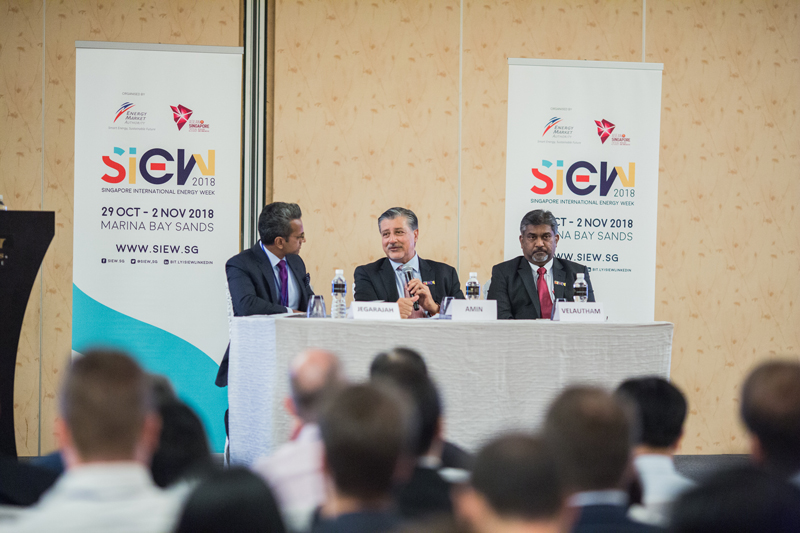The Energy Market Authority (EMA) announced the theme for the Singapore International Energy Week (SIEW) 2018, “Transforming Energy: Invest, Innovate, Integrate”, which reflects how the deployment and integration of new technologies, and the growth in energy demand are transforming the energy landscape.
To facilitate this transition, Mr Ngiam Shih Chun, Chief Executive, EMA, highlighted that “it is important to address capital market barriers and foster an enabling environment for infrastructure investment.” Against this backdrop, SIEW 2018 will continue to reinforce collaboration with international organisations and the business community enabling ASEAN to further engage with global energy players.
Mr Adnan Amin, Director-General, International Renewable Energy Agency (IRENA) said in his opening keynote that the global energy transformation is driven by the business case for renewables which has never been stronger. “Technological innovation coupled with digitalisation, big data and artificial intelligence are further fuelling this change and are reshaping the way energy is produced, distributed and consumed.”
The Global Launch of SIEW saw a lively discussion on the future of energy in ASEAN. In particular, the panel discussion featuring Mr Amin and Dr Sanjayan Velautham, Executive Director, ASEAN Centre for Energy (ACE) touched on key energy issues such as energy connectivity, renewables investment and innovation in Southeast Asia.

Mr Amin and Dr Velautham having a spirited discussion at the panel discussion moderated by CNBC Senior Correspondent, Sri Jegarajah
What is ASEAN focusing on in terms of energy innovation?
ASEAN is committed to renewables, but it also needs to consider the security of energy supply, affordability and other economic factors, said Dr Velautham. The priority is bringing affordable and accessible electricity to the 100 million people in Southeast Asia who still lack access.
“Technology in all its different guises is going to be part of the solution we need,” he highlighted.
Promoting innovation among ASEAN member states is a key focus for Singapore as it chairs the ASEAN meetings this year with the overarching theme of “Resilience and Innovation”.
Mr Amin commented that Singapore’s leadership in research and innovation strongly positions the country to facilitate ASEAN’s efforts towards a secure, affordable and sustainable energy future.
“Singapore’s growing investment in research and development to integrate renewable energy into urban environment and build smart energy efficient low carbon cities are an important contribution to global innovation efforts in the field,” he said.
Where will renewable energy investments in ASEAN come from?
Renewables have a strong business case, said Mr Amin. He cited that China had installed 53GW of solar, more than the total installed solar capacity of the US, in one year. This was done at a levelised cost of electricity of just over five cents per kilowatt hour, which is “very close” to the cost of coal.
Capital is also not a challenge, according to the IRENA chief who noted that 92 per cent of investment in renewables worldwide comes from the private sector.
With renewable technologies becoming increasingly mature and affordable; policy and regulatory frameworks are key to providing security to investors and unlocking the necessary financing.
“This is why it’s important that SIEW is in Singapore because Singapore is the innovative finance hub of ASEAN,” said Mr Amin. “This is where the knowledge and capacity exist to create investment mechanisms to lead us to a positive energy future.”
When can we expect a fully connected ASEAN energy grid?
ASEAN has been making “comfortable” progress on the ASEAN Power Grid (APG) since the initiative began in 1997 to enhance regional distribution of energy resources, said Dr Velautham.
To date, eight of the 16 bilateral power interconnection projects for the APG have been completed, with a total of 5,200 MW in power exchange. More significantly, electricity was traded across multiple borders for the first time between Laos, Thailand and Malaysia.
This landmark will pave the way for a better understanding on how to structure multilateral frameworks for more flexibility and integration. Studies on this are currently ongoing at ACE and will be presented at the next round of ministerial meetings in 2019, said Dr Velautham.
Mr Amin noted in his opening keynote that ASEAN is in a strong position to leverage its role as a financial, manufacturing and economic hub to leapfrog fossil fuel-based energy generation and benefit from the substantial socioeconomic benefits of renewable energy.
“The ASEAN countries are at the heart of this changing global energy landscape as they seek to design their future energy systems against the background of rapid urbanisation, growing populations, economic growth and increasing income,” he said.
More updates on energy in the ASEAN member states will be shared at the 36th ASEAN Ministers on Energy Meeting (AMEM), which is being held together with SIEW 2018.